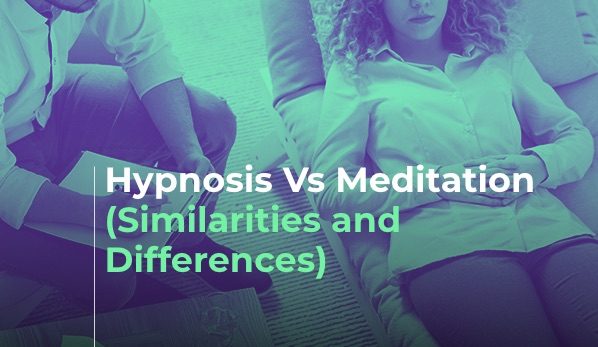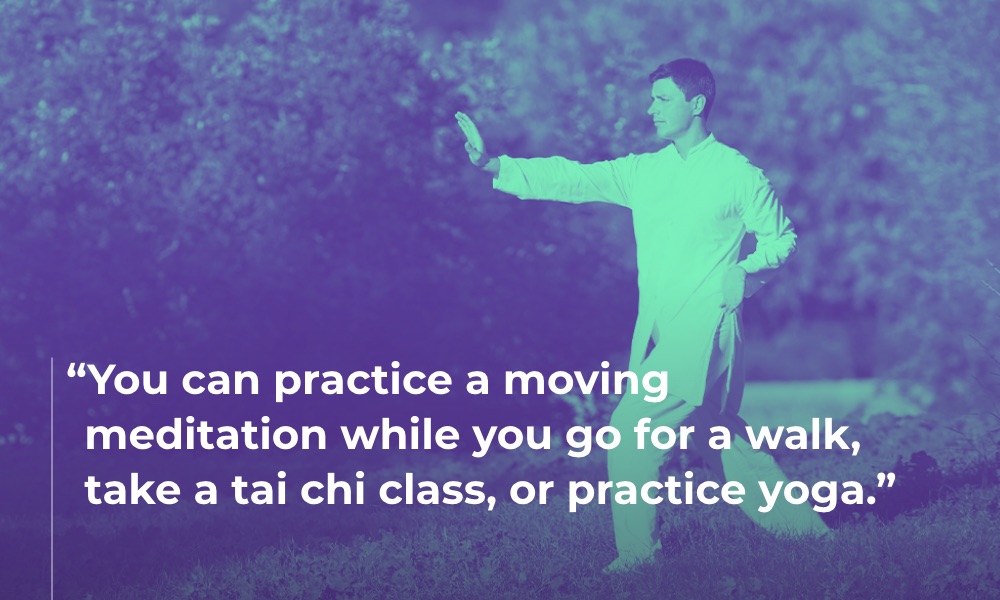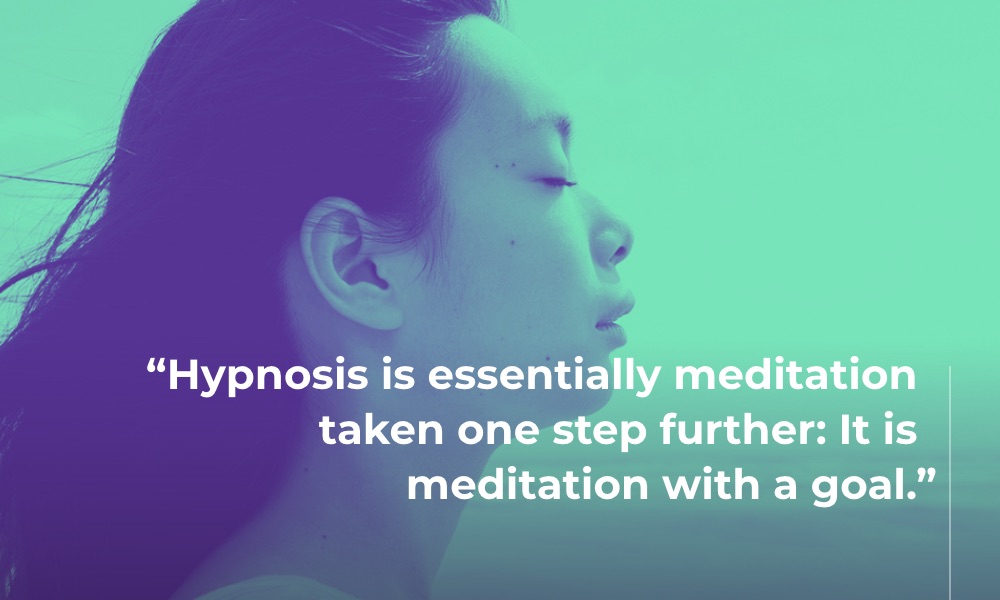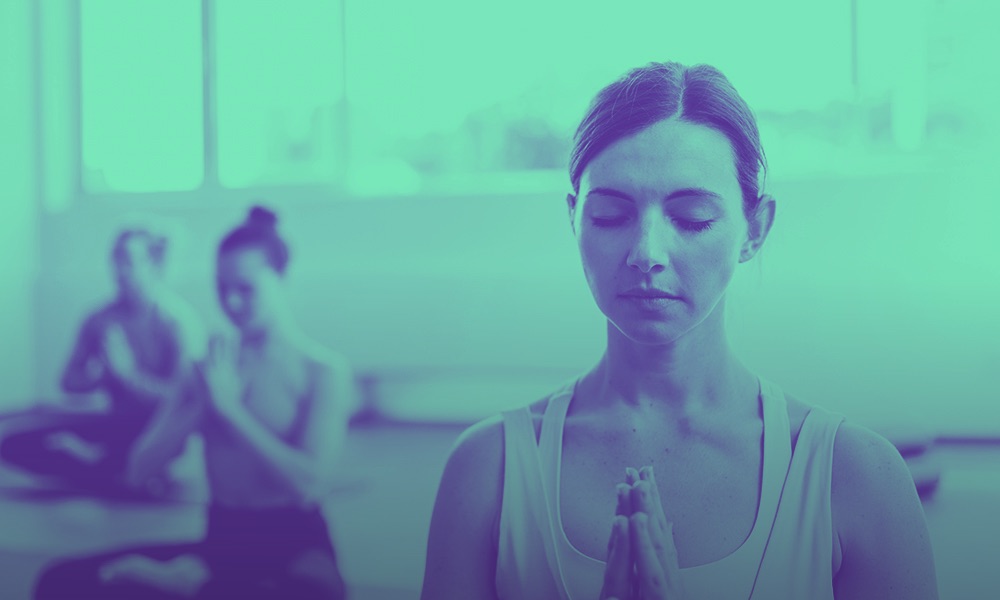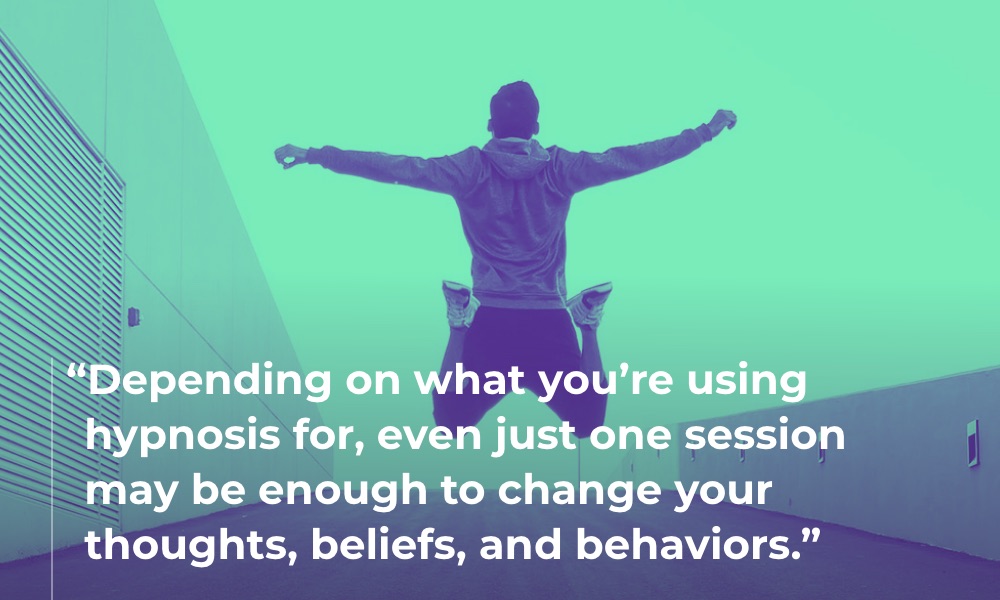Even if you’re a regular meditator, you may not be familiar with hypnosis. However, the two practices are more similar than you may think. They both involve a state of relaxation and deep concentration. In fact, hypnosis is sometimes considered a type of meditation.
You can generally think of hypnosis vs meditation in this way:
Meditation is a state of heightened relaxation and focus. The goal of meditation is to develop an awareness of self.
Hypnosis is a state of heightened relaxation and focus during which you hear helpful suggestions. The goal of hypnosis is to alter your behavior through suggestions, visualizations, and exploring your memories and beliefs.
While you use meditation to help you cultivate a general awareness and presence, you use hypnosis to help you achieve a specific aim, like eliminating bad habits or improving your performance in important areas of life.
In this article, we explore the similarities and differences between the hypnotic state and the meditative state.
What is Meditation?
Let’s start by understanding meditation. Because there are so many forms of meditation, it’s hard to pin down exactly where it came from. However, it has gained popularity over the last few years as more people are catching on to the benefits it has on performance and cultivating a sense of well being, rather than just as part of a spiritual practice.
Meditation is an intentional practice. In it, you use mindfulness—keeping your attention on the present moment—to relax and center your mind. This may look like training all of your thoughts to focus on the pattern of your breath. Or it may look like scanning your body for different sensations.
When you meditate, you notice any distracting thoughts that come up, and then you gently release them.
Meditation is something you practice; it’s a way to train your brain. It’s not, however, a way to empty your thoughts (which is a common misconception).
There are many meditation types, but one of the most frequently practiced is a mindfulness meditation with a focus on the breath. To do this type of meditation, follow these steps:
- Sit on the floor with your legs crossed, or sit in a chair. Elongate your back.
- Begin by taking a few slow, deep breaths. Draw your attention to each inhale and each exhale.
- Then, return to your normal breathing pattern, but continue to follow your breath.
- Each time your mind wanders, simply acknowledge your thoughts and then return to your breath.
- Congratulations, you’ve done a mindfulness meditation!
There are dozens of meditation types to choose from, so you’ll never get bored.
You might try a moving meditation. This is where you direct all of your attention to the sensations of your body as it moves. You can practice a moving meditation while you go for a walk, take a tai chi class, or practice yoga.
Or, you might try a loving-kindness meditation. This is where you send thoughts of love, compassion, and acceptance to yourself and others. To learn about all of the different ways you can practice, we recommend checking out our article on types of meditation.
The goal of meditation is to help you live in the present moment. This presence leads to a host of other benefits, such as:
- Reduced stress symptoms
- An improved attention span
- Decreased anxiety
- A reduction in memory loss
- Better sleep quality
Meditation is an excellent way to cultivate awareness. Plus, it can help you practice tuning into your body and mind before trying a hypnosis session.
A Guided Mindfulness Meditation
If you’d like to try your hand at a guided mindfulness meditation, follow this primer:
What is Hypnosis?
Like meditation, hypnosis is a state of consciousness marked by intense focus and deep relaxation. It’s not the same as being asleep. However, while you’re hypnotized (or meditating), your trance-like state may make it look like you’re asleep to an outside observer.
When you’re hypnotized, you experience a similar feeling to when you’re watching a fascinating movie, however in this case the movie is being projected by your mind. You’re at ease; you’ve tuned out the world around you; and you’re focusing all of your attention on what you’re doing.
The goal of hypnosis is to bypass the conscious part of your mind, so that you can communicate with the unconscious part. The unconscious mind (often called the “subconscious mind”) is the part that holds all of your deep conditioning and behavior patterns. It even makes most of your decisions for you without you realizing it.
Once you reach the unconscious mind, the conscious mind is less likely to dismiss the helpful suggestions that you hear. Hypnosis can then help you identify deeply rooted fears, memories, and beliefs. By unlocking the underlying reasons for your behavior, hypnosis can affect behavioral change in ways that you simply cannot in a typical state of wakefulness. Whether that means helping you become more self-confident, quit smoking, or lose weight, hypnotherapy can help.
Hypnosis is can lead to a lot of positive outcomes, including (but not limited to):
- Reduced anxiety and stress
- Improved sleep quality
- Lessened symptoms of irritable bowel syndrome (IBS)
- Decreased pain
For best results, include both hypnosis and meditation in your practice.
A Guided Self Hypnosis Meditation
If you’d like to experience hypnosis, try one of our hypnotic primers.
How are Hypnosis and Meditation Similar?
Hypnosis is meditation with a goal — Hypnosis is essentially meditation taken one step further: It is meditation with a goal. You use the relaxed hypnotic trance to achieve a specific outcome, whether that’s reducing anxiety, falling asleep, improving focus on a specific task, or eliminating fears and limiting beliefs.
Hypnosis induction is like guided meditation — The induction phase of hypnosis is at the very beginning. This is when you’re guided into a relaxed and attentive state of hypnosis. The induction phase is very similar to a guided meditation.
Similar Benefits — Hypnosis and meditation also have many of the same benefits, such as:
- Decreased anxiety
- Reduced stress
- Increased self-awareness
- Improved sleep
- Increased general well-being
Science-Backed, Safe, and Accessible — Both practices are safe, neuroscience-backed, and natural. They generally have no side effects at all. Plus, you can practice both from the comfort of your own home.
Enhance mental health and well-being — They’re both excellent for your mental state. They invite you to practice mindfulness, and they require a willingness to tune into yourself and explore your own mind.
They are time investments — You must be intentional about setting aside for both hypnosis and meditation. Unlike general mindfulness, they’re not something you practice throughout the day while you’re also doing other things. They require dedicated time. However with Primed Mind, you can get the benefits of hypnosis in just a few minutes each day.
What Are The Differences Between Hypnosis and Meditation?
Hypnosis is meditation, but meditation may not be hypnosis — You may remember from math class that every square is a rectangle, but not every rectangle is a square. Similarly, virtually every hypnosis session is a meditation, but not every meditation practice is a hypnosis session.
Hypnosis intentionally alters behavior — While a typical mindfulness meditation practice may very well change your behavior over time, it’s not designed to do so. Hypnosis, on the other hand, targets behaviors to change. It’s focus is to alter certain parts of your behaviors, fears, beliefs, or thought patterns for the better.
Hypnosis is Active; Meditation is Passive — Meditation is passive. It encourages you to sit and let go of your thoughts. But hypnosis is active. Hypnosis may ask that you recall certain memories, envision certain scenarios, or delve into certain beliefs.
Meditation is about detaching and distancing yourself from your thoughts, while hypnosis puts you in an altered state that actively engages your unconscious mind to steer it in the direction you want to go.
Frequently Asked Questions about Hypnosis vs. Meditation
If you’re new to hypnosis, meditation, or both, you may have some questions. Here are a few of the ones we get asked most often about hypnosis vs. meditation.
Are Hypnosis and Meditation the Same?
Hypnosis and meditation are not the same. However, you can think of hypnosis as a type of meditation. Meditation aims to cultivate awareness and presence, and hypnosis does too. However, hypnosis has more elements designed to influence your behavior. With hypnosis, you may hear helpful suggestions or be asked to recall old memories.
Is Guided Meditation a Form of Hypnosis?
Guided meditation is not always a form of hypnosis. However, the induction phase of hypnosis—when you’re guided into a relaxed and focused state that brings your unconscious to the surface—often resembles a guided meditation. Like a guided meditation, guided hypnosis is led by a calm, soothing voice that helps you ease into a restful state. This might be achieved through imagery, metaphors, music, and more.
Is Mindfulness a Form of Hypnosis?
Mindfulness is a part of hypnosis. When you practice mindfulness, you direct all of your attention to the present moment. While mindfulness is not the same as hypnosis, hypnosis does require the use of mindfulness to be successful. During a hypnosis session, you’re very relaxed and very attuned to what’s going on within you thanks to mindfulness.
Are Meditation and Hypnosis Safe?
Hypnosis is a safe, effective, and natural therapy for many conditions. It treats addiction, anxiety, depression, and more. Many people use it as a complement to other behavioral-change methods. If you’re already using cognitive-behavioral therapy or medicinal therapies, try adding hypnosis to your regimen.
Almost anyone, including children, can use hypnosis. It’s been used and trusted by everyone— from health-conscious Olympic athletes to A-list celebrities and even intellectuals like Albert Einstein.
Can You Do Hypnosis on Yourself?
Just like you can meditate on your own, you can also hypnotize yourself on your own. Self-hypnosis works best for addressing anxious or painful feelings or for creating a sense of relaxation. For example, if you get very nervous before a routine doctor appointment, you may learn to use self-hypnosis to induce a sense of calm before you go in.
Self-hypnosis may not be the best option if you’re looking to explore some of the unconscious roadblocks that are hindering your success Nor would it be best if you have very specific goals you’re trying to achieve, like if you want to become better at public speaking or achieve weight loss. For that, it’s best to work with a trained practitioner (hypnotherapist or hypnotist) or use a guided hypnosis app with specialty hypnosis primers, like Primed Mind.
Are Hypnosis Results Long-Lasting?
In the same way that meditation can have a long-lasting positive impact, so too can hypnosis. Depending on what you’re using hypnosis for, even just one session may be enough to change your thoughts, beliefs, and behaviors.
Additionally, it may be beneficial to combine hypnosis with other therapeutic practices, like cognitive behavioral therapy. Studies suggest the combined methods tend to have longer-lasting results than cognitive behavioral therapy alone.
If you want to boost the results you experience over time, it’s always safe to do another hypnosis session. That’s the benefit of going the all-natural route!
Using Primed Mind for Hypnosis Meditation
Hypnosis and meditation are very closely related. They both put you in similar states of mind, and most hypnosis sessions are a type of meditation. Generally speaking, meditation is great for cultivating awareness and presence, while the goal of hypnosis is to help you tackle a specific goal. This makes hypnotherapy a great way to invest your time since you get the relaxation benefits of meditation and the behavioral-change benefits of hypnotism.
Primed Mind is a hypnosis meditation app. It helps you tap into the powerful, unconscious part of your mind to make lasting positive changes to your thoughts and behaviors.
It’s free to download, and you can choose from tons of mindset audios. The 5 to 20 minute audio sessions include improving your confidence, overcoming an addiction, and even falling asleep at night. Give it a try today to start experiencing the benefits of meditation and hypnosis, all wrapped into one!

